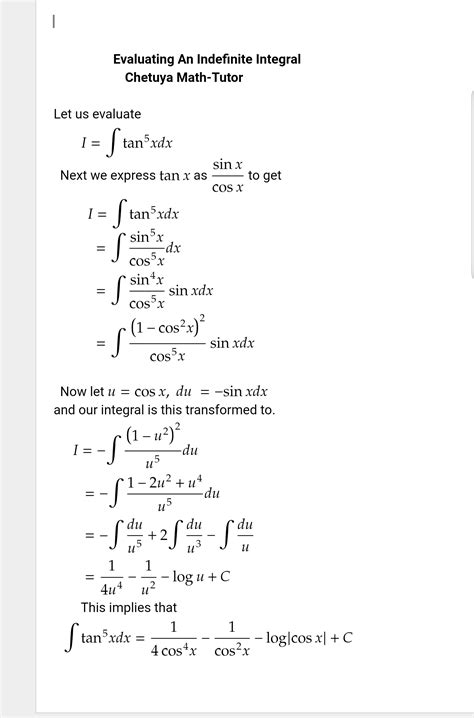Introduction
Trigonometric identities and calculus are two fundamental concepts in mathematics that play a crucial role in solving complex problems. Understanding their intricate relationship enables students and professionals alike to tackle real-world scenarios with greater precision and efficiency. This comprehensive guide delves into the synergistic connection between trig identities and calculus, providing a step-by-step approach to unlocking their transformative potential.

Unveiling the Interplay of Trigonometric Identities and Calculus
Trig identities form the cornerstone of trigonometric operations, establishing valuable relationships between trigonometric functions. These identities include fundamental formulas such as the Pythagorean identity (sin²θ + cos²θ = 1), angle sum and difference identities (sin(A ± B) = sin A cos B ± cos A sin B), and double and half-angle formulas (sin 2θ = 2 sin θ cos θ).
Calculus, on the other hand, empowers us to analyze change and motion. It provides methods for determining the rate of change (derivatives) and the total change (integrals). The combination of trig identities and calculus yields a powerful toolset for solving problems in various fields, including physics, engineering, and finance.
Step-by-Step Approach to Utilizing Trig Identities in Calculus
1. Identify the Trig Function in the Calculus Problem
The first step involves recognizing the presence of a trigonometric function within the calculus problem. This function could appear as a derivative or integral.
2. Apply Relevant Trig Identities
Based on the identified trig function, select appropriate trig identities to simplify the expression. For instance, if the derivative of sin(x) is required, the following identity can be employed: d(sin x)/dx = cos x.
3. Compute Derivatives and Integrals
Once the expression is simplified using trig identities, apply standard derivative or integral rules to determine the result. Remember to apply the chain rule when dealing with complex trigonometric functions.
Why Trig Identities Matter in Calculus
Enhanced Problem-Solving Abilities
Incorporating trig identities into calculus expands the range of problems that can be solved. It empowers individuals to tackle more complex and challenging scenarios with increased accuracy and confidence.
Time-Saving and Efficiency
By skillfully utilizing trig identities, individuals can save time and improve the efficiency of their problem-solving efforts. These identities allow for the simplification of expressions, leading to faster and smoother calculations.
Increased Precision
Trig identities provide a solid foundation for achieving greater precision in calculus problems. Their accuracy ensures that results align with theoretical expectations and practical applications.
Benefits of Using Trig Identities in Calculus
Improved Modeling Capabilities
The combined power of trig identities and calculus enables the creation of more refined and precise mathematical models. These models accurately represent real-world phenomena, providing valuable insights for decision-making and problem-solving.
Enhanced Understanding of Periodic Phenomena
Trig identities play a vital role in understanding periodic phenomena, such as the motion of planets or the oscillation of springs. They allow for the analysis of repeating patterns and the prediction of future behavior.
Innovation and Discovery
The synergy between trig identities and calculus fosters innovation and discovery in diverse fields. By leveraging these concepts, researchers can explore new avenues and push the boundaries of human knowledge.
Tables for Enhanced Understanding
Table 1: Fundamental Trig Identities
| Identity | Formula |
|---|---|
| Pythagorean Identity | sin²θ + cos²θ = 1 |
| Angle Sum Identity | sin(A + B) = sin A cos B + cos A sin B |
| Angle Difference Identity | sin(A – B) = sin A cos B – cos A sin B |
| Double-Angle Identity | sin 2θ = 2 sin θ cos θ |
| Half-Angle Identity | sin (θ/2) = ±√((1 – cos θ)/2) |
Table 2: Derivatives of Trig Functions
| Function | Derivative |
|---|---|
| sin x | cos x |
| cos x | -sin x |
| tan x | sec² x |
| cot x | -csc² x |
| sec x | sec x tan x |
| csc x | -csc x cot x |
Table 3: Integrals of Trig Functions
| Function | Integral |
|---|---|
| sin x | -cos x + C |
| cos x | sin x + C |
| tan x | ln |
| cot x | ln |
| sec x | ln |
| csc x | -ln |
Table 4: Applications of Trig Identities and Calculus
| Field | Application |
|---|---|
| Physics | Modeling projectile motion, oscillatory systems |
| Engineering | Structural analysis, fluid dynamics |
| Finance | Option pricing, risk analysis |
| Music | Analysis of sound waves, composition algorithms |
FAQs
Q: How can I improve my skills in utilizing trig identities and calculus?
A: Practice is key. Regularly solve problems that involve the application of trig identities in calculus. Seek guidance from experts and consult reference materials to deepen your understanding.
Q: Are there any software tools that can assist me with trig identities and calculus?
A: Yes, various software programs, such as MATLAB and Wolfram Alpha, offer built-in functions for evaluating trig identities and performing calculus operations.
Q: How do trig identities and calculus contribute to career opportunities?
A: Proficiency in trig identities and calculus opens doors to a wide range of careers in science, engineering, finance, and research. Employers value individuals who can use these concepts to solve complex problems and drive innovation.
Q: What is the most innovative application of trig identities and calculus that you have come across?
A: One innovative application involves using these concepts to develop algorithms for generating realistic-looking 3D models. This technique is revolutionizing the film, gaming, and architecture industries.
